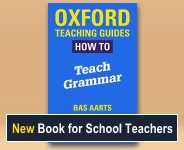About ICEBox
 Traditional grammars have relied on ‘made-up’ examples. Englicious is different.
Traditional grammars have relied on ‘made-up’ examples. Englicious is different.
Instead of example sentences like
- The cat sat on the mat
we have examples like
-
error: no data
Our examples come from natural language corpora. They have been spoken or written by real people. Grammar is the study of the structure of actual English or it is nothing!
Often examples are selected and presented in real time using our ICEBox database technology. This technology is also part of our ICECUP software supplied to academic linguists.
You can see this in operation. If you reload this page you will see different examples.
The advantages are immediately apparent. Most obviously, we can obtain as many ‘real’ examples as we like to aid classroom discussion. Let's look at some examples.
Dynamic examples
- 10 common nouns: error: no data
- 4 sentences with common nouns (including compound nouns) highlighted:
-
error: no data
Note: Codes of the form [S1A-001 #1] specify the text (S1A-001) and sentence unit (#1) in ICE-GB. Spoken texts have codes starting with S, while written texts have codes starting with W.
We also use examples in some dynamic exercises, so you can also have as many revision exercises as you like.
Why real language is beneficial for teaching
Grammatical concepts can seem very abstract. Stereotypical examples of nouns (cat, mat, etc.) are not much help to students when real uses may be ‘messy’ and far from stereotypical, as we have seen.
This observation informs our approach. We believe it is necessary for students to apply grammatical concepts to real sentences in order to learn them properly. Thankfully, thanks to our corpus resources we have very many real sentences to use.
Ultimately we want students to be able to apply what they have learned to their own language, not just stereotypical sentences they never say or write!
Why is real language not always helpful?
That said, there are many times when simply taking random examples of real language is not ideal for teaching purposes. Examples may be too complex or contain words that are inappropriate, particularly for younger children. And teachers often want to focus on simple structures for sound pedagogical reasons.
So in fact, Englicious contains a variety of types of example.
- Random examples drawn unexpurgated from the corpus.
- Selected examples taken from the corpus, and possibly edited to make them simpler.
- Invented examples, especially for younger children.

